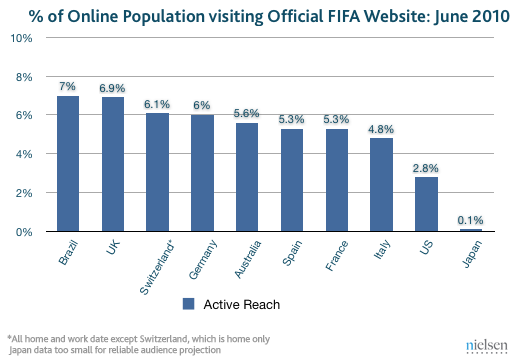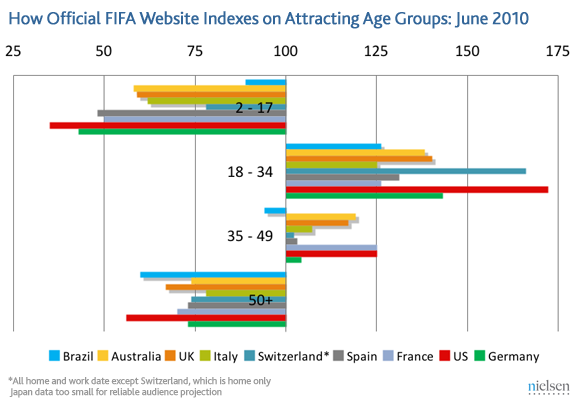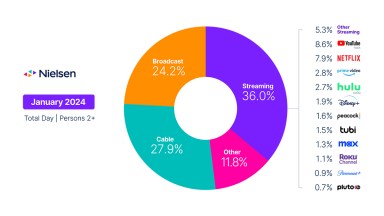As the curtain fell on the World Cup and team and player performances were analyzed across the world, The Nielsen Company looked at how the official FIFA website performed across a number of countries that participated in the tournament.
During June – which accounted for the first three weeks of the tournament and the 10 days preceding it – the FIFA website proved to be most popular in Brazil (visited by 7.0% of Brazilians online, 2.8 million people) and in the U.K. (6.9% of people online, 2.7 million). Despite their tournament ending on the 25th June, Switzerland followed with 5.6% of Swiss people online (0.25 million people) visiting FIFA’s site, probably driven by the team’s shock opening round victory over eventual winners Spain.
The FIFA site offers versions in English, Spanish, German, French, Portuguese, Arabic and International Sign, but not Italian or Japanese. Despite this, 4.8% of Italians online (1.2 million people) still visited the site during June, although the lack of the local language did prove too much of an obstacle in Japan where only 0.1% of Japanese people online visited the site.
“The reach that the FIFA site achieved is impressive considering the kaleidoscopic variety of competing soccer, general sports and news sites available to consumers to follow such a large global event,” said Alex Burmaster, VP Global Communications at Nielsen’s online division. “The fact that one in 14 Brazilians online, for example, went to FIFA’s site in such a cluttered online environment illustrates a level of achievement.”

Not only did the FIFA website have the biggest footprint in Brazil but it also witnessed the most engaged audience – Brazilian visitors averaged almost 28 minutes on the site during June. In the U.S., although the site had a relatively low penetration among countries under Nielsen’s measurement (2.8% of Americans online visited the site) the U.S. actually provided the most total visitors to the site (5.4 million people) and, following Brazilians, the U.S. was the most engaged audience at almost 22 minutes per visitor for the month.
“The U.S. outperformed expectations in the World Cup and the FIFA site had a highly engaged core of US consumers who averaged more time on the site than fans in more traditionally soccer-mad nations such as England, Germany, Spain and France,” noted Burmaster. “The FIFA website provided a huge, and welcome, buffet of World Cup information from which U.S. soccer fans could satisfy their appetite over and above the relatively light offering in U.S. mainstream media compared to the near saturated coverage in more established soccer countries.”

In all the markets, except one, the FIFA website – when compared to the overall Internet audience in each country – was overly-weighted towards male visitors and struggled on attracting females.
The site had the most male-dominated audience in Brazil (71% male) and Australia (70%), while in Italy (67%) and Spain (66%) it also had at least-two thirds male visitors.
Germany was the only country in which the site had more female (54%) than male visitors (46%) and it was also the only market in which it over-performed – relative to the entire online audience – on attracting females and under-performed on attracting males.

In all the countries under measurement, the FIFA website was overly-weighted towards 18-49 year olds – particularly the 18-34 segment – while it struggled on attracting visitors under 18 and those over 50.
The greatest contrast between the make-up of FIFA’s audience compared to the overall Internet audience occurred in the U.S. market. In the U.S., the site over-performed most heavily on attracting 18-49 year olds and under-performed most on attracting people under 18 and those over 50.

In most of the countries, the majority of FIFA’s online audience was over 35 years old – particularly in France where almost 60% were over 35. Only in Spain (47%) and Brazil (34%) did the site have fewer visitors over 35 compared to those under 35.
“Across the globe, the FIFA site tends to be a destination for 18-49 year old males. The World Cup represents a unique opportunity for brands to connect with this highly engaged, mid-age-range male-dominated audience as reflected by sponsors who are in the business of producing beer, car tyres and engine oil,” said Burmaster. “Castrol, for example, scored a masterstroke in sponsoring the statistics section of the World Cup website. Consequently, they will have connected with large numbers of this often elusive audience across a wide range of markets at a time when they’re notoriously engaged – checking out soccer stats.”




